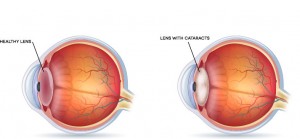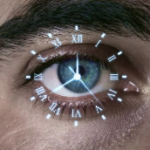About Cataracts

A cataract is a clouding of the natural internal focusing lens inside the eye, which is normally clear in youth, gradually developing density over a lifetime. Cataracts typically do not cause vision problems until the age of 65+. Generally, cataracts progress at about the same rate in both eyes; however, many people seem to notice cataract symptoms in one eye first.
Check out our FREE cataract surgery guide here.
Recently, there was a story on the Today Show regarding the early onset of cataracts. Studies have shown an increase of cataracts have been seen in patients in their 40s. Read the story here.
If you’ve been diagnosed with cataracts, or you suspect you may have a cataract, there’s no need to worry. Cataracts are very common and occur naturally with age. They are also very easily treated. In fact, cataract surgery is the most common elective surgery done in the United States.
There are different types of cataracts.
- A nuclear cataract forms in the lens. This is the most common cataract and people over 65 are more prone to develop this type of cataract.
- A cortical cataract forms in the lens, then grows from the outside to the center of the lens. Diabetics often develop this type of cataract.
- A subcapsular cataract forms in the back of the lens. Those with diabetes, far-sightedness, or retinitis pigmentosa may be at a higher risk to develop this type of cataract.
Cataract Causes
Cataracts develop because of a natural aging process in the lens itself. In fact, the average age for cataract surgery is the early 70s. Ultraviolet light exposure may play a role in the development of cataracts, but otherwise we aren’t completely certain of the cause. Some cataracts occur in younger people due to direct trauma to the eye (such as getting hit in the eye with a baseball), genetic conditions, medications, or occasionally vitamin deficiencies.
Wearing ultraviolet (UV) protecting sunglasses may help reduce the progression of cataracts. In addition, a balanced diet containing a reasonable amount of antioxidant vitamins may help slow the progression of cataracts, while supporting overall health.
Cataract Symptoms
If you are over the age of 60 and experiencing hazy, cloudy, or blurred vision, there is a good chance you may have cataracts. Early on, cataract symptoms can be very mild. Driving at night is when many people first notice the signs of having cataracts. They may experience distracting glare from oncoming headlights or find it harder to read street signs. Oftentimes, reading in low light will be difficult.
Signs you may have cataracts:
- Decline in your distance and reading vision
- Hazy, fuzzy, cloudy, or blurred vision
- Increased sensitivity to light and glare (especially at night)
- Lower night vision
NEXT STEPS
If you think you may have cataracts or have been told you do, it is important to schedule an appointment.
Get in touch with us today at our nearest location to you.


